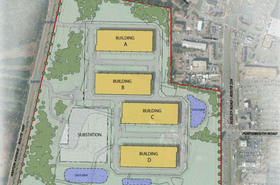In the past couple of years, we have watched AI dominate pretty much every headline (at least at DCD, it has felt like that) and, for the most part, the focus has been on massive investment, infrastructure development, technology changes like increasing densities, liquid cooling, and of course - chips, chips, chips.
But, as DCD’s Cloud & Hybrid reporter, perhaps the most notable thing to me has been the proliferation of “AI cloud” companies that have either emerged out of seemingly nowhere, pivoted from cryptomining operations, or are just IT and service providers taking advantage of the demand.
It’s become something of a running joke between my editor and me. “Another GPU cloud? Just another week at the office.”
The industry is flourishing - investment abounds - but there are growing rumblings. Talks of an “AI” bubble have been on-going since initial interest ramped up, but recent reports seem to hint that maybe, that bubble burst is edging closer and closer.
Both Amazon Web Services (AWS) and Microsoft have been closely scrutinized for their seemingly reduced number of data center projects in recent months, though both maintain that this is just business as usual and they are managing capacity according to where they need it.
Microsoft’s president of cloud operations, Noelle Walsh, said in a LinkedIn post: "By nature, any significant new endeavor at this size and scale requires agility and refinement as we learn and grow with our customers. What this means is that we are slowing or pausing some early-stage projects. While we may strategically pace our plans, we will continue to grow strongly and allocate investments that stay aligned with business priorities and customer demand."
On the other side of the world, Alibaba Group chairman Joe Tsai publicly voiced concerns about “the beginning of some kind of bubble,” specifically noting that “People are talking, literally talking about $500 billion, several 100 billion dollars. I don’t think that’s entirely necessary. I think in a way, people are investing ahead of the demand that they’re seeing today, but they are projecting much bigger demand.”
At the same time, CoreWeave - perhaps one of the biggest players in the AI cloud or “neo-cloud” space started trading on the Nasdaq stock exchange.
A very exciting development - for the sector, and for CoreWeave itself, but somewhat marred by the IPO’s potential raise of up to $1.5 billion, $4 billion less than that had previously been mooted and off the back of reports that Microsoft had allegedly canceled some contracts.
Within all of this, however, the number of GPU clouds has continued to creep up. March 2025 alone saw Tata Communications launch its Vayu cloud, the birth of Neon Cloud, as well as the arrival of alt Inc's alt GPU Cloud, and Cartagon.ai, among others.
Author of ‘The GPU’ newsletter and business development lead of Panchaea, Ben Baldieri, estimates to DCD that around 145 GPU cloud companies have popped up in recent years.
“This ranges from the big players, all the way down to the tiny niche providers who’ve ended up with a direct relationship with Nvidia of some sort, and set up a small sovereign cloud or something,” Baldieri explains.
He separates the “neoclouds” into Tiers, dubbing Tier One as the large companies - the “CoreWeaves, the Lambdas, the Nebius’” who are all “incredibly well capitalized” and have either their own data center footprints, or massive colocation contracts.
Then there are “Tier Two,” which have some private contracts, but maybe not dedicated footprints, and whose offerings are mostly limited to bare metal or similar, and “Tier Three,” which Baldieri says are mostly resellers or brokers, selling the same capacity over and over again.
Earlier this month, DCD spoke with AI deployment network Parasail’s CEO and founder, Mike Henry, about the number of providers in the market.
Henry disputed that there was an issue with oversaturation, telling DCD: "I don't really think there is a limit to the demand side. We didn't decide to build another GPU cloud, we looked at what customers wanted - great prices on demand, the latest hardware, the best speeds, etc."
He added: "I don't think there's over saturation at all, I think we're just getting started, to be honest."
This could very well be the case. On the other hand, we have been here before. What goes up, must - at some point - go down.
Within the “Tier Two” companies, Baldieri anticipates there will be some market consolidation.
“Some of those mid-markets have really interesting software. Virtualization, for example. So I wouldn’t be surprised if there are some acquisitions in that vein.”
He adds that he could see some GPU clouds moving into specific verticals to differentiate themselves, because “if you’re able to niche down far enough, you’re not competing with anyone.”
Baldieri speaks positively about the future for the Tier One companies, which he suggests could pivot towards a public AI cloud model of the ilk we are used to seeing from AWS, Microsoft, Google, and others, though this would bring them even more directly in competition with the hyperscalers.
On the Tier Three front, Baldieri says: “I think they are always going to exist. There’s always going to be a case where someone comes to the end of a contract on X amount of GPUs and they are still turned on, and there’s a market to sell that remaining capacity.”
Overall, Baldieri seems to expect change, and one that companies will need to adapt to, but not shocking collapse - which is good news for the AI stocks that have suffered a tumultuous few months of late.
But it is whether the GPU cloud providers successfully adapt to change that will depend on their longevity.
Ditlev Bredahl is CEO of hosted.AI, a company offering a GPU orchestration platform to help GPUaaS providers, and has some qualms about the future of the market.
When asked if he sees any parallels between the current boom, and that of when cloud computing first grew in popularity, Bredahl says: “There are a bunch of things that are different.”
“The barrier for entry with the cloud was different, you actually had the option of setting up a few servers, tying them together, and getting some open storage, and you were in business. But the specific hardware for GPUaaS business is, at a minimum, half a million dollars or so of investment. It introduces a whole load of barriers.”
But beyond that, Bredahl notes the volatility of hardware costs as a significant problem.
He draws a comparison to that of a landlord, explaining that if you buy property with a mortgage, but rental prices suddenly drop, then you are in trouble.
“A year ago or so, an H100 was maybe $5-6 per hour. Now, it's around 75 cents, maybe less. Hardware typically depreciates in three to five years, but that's happening in a year now.
“Let’s say your leasing cost is fixed over three years or even five years. But if your revenue is eroded by 80 percent in just 12 months, then you have a real problem.”
Bredahl adds: “All these guys, the CoreWeaves and Lambdas, they have a one-to-one relationship between the rental property and the customer.”
This is a reality that is not even denied by the chip companies.
At the recent GTC conference, Nvidia CEO Jensen Huang said during his keynote: “When Blackwell starts shipping in volume, you couldn’t give Hoppers away.”
Speaking on this, Bredahl noted: “He had billions of dollars of spend sitting in the audience in front of him. It’s not a very well-placed joke.”
But beyond the issue of rapid depreciation of hardware value, Bredahl thinks a major issue is that as we move away from training large models, and move towards inference, suddenly the need for GPU clouds will be for always available compute, and the GPU clouds simply don't have the same uptime guarantees that the data center world has spent years perfecting.
Lambda does not guarantee Uptime at all - stating it is “provided ‘as is’ and ‘as available’.” CoreWeave guarantees 99.9 percent in multiple regions, and 99 percent in a single region. Nebius offers 99.5 percent for Compute Cloud and 99.9 percent for Kubernetes managed services.
This sounds like a lot, but data center and cloud providers have gotten used to aiming as high as possible. Uptime Institute’s tier system goes up to Tier 4 - which requires a 99.995 percent uptime, or just 29.3 minutes of downtime a year.
For comparison, 99 percent of uptime is around 87.6 hours of downtime annually, or 7.3 hours per month.
Then there is the concern of utilization rates. CoreWeave published a blog earlier this year, noting that it achieves a “Model Flops Utilization (MFU) exceeding 50 percent on Nvidia Hopper GPUs— driving up to 20 percent higher performance than public foundation model training benchmarks, which typically range from 35 percent to 45 percent.”
But that is still half that are being lost to inefficiencies, and representing billions of dollars.
For Bredahl, all of this contributes to a serious concern for the major GPU cloud providers - many of which have a large pile of debt behind them.
“If your underlying economics are not working, then you are even more vulnerable than the tier two companies that are more agile and can change their go-to-market strategy. If you’ve tied billions of dollars to GPUs, and then you aren’t even able to give them away when the new version comes in… I think we are about to see a massive shake-up.”
“Something will fail, and the model will fall apart. It's on stage, and I think that's what we're seeing happening in front of our eyes right now.”







